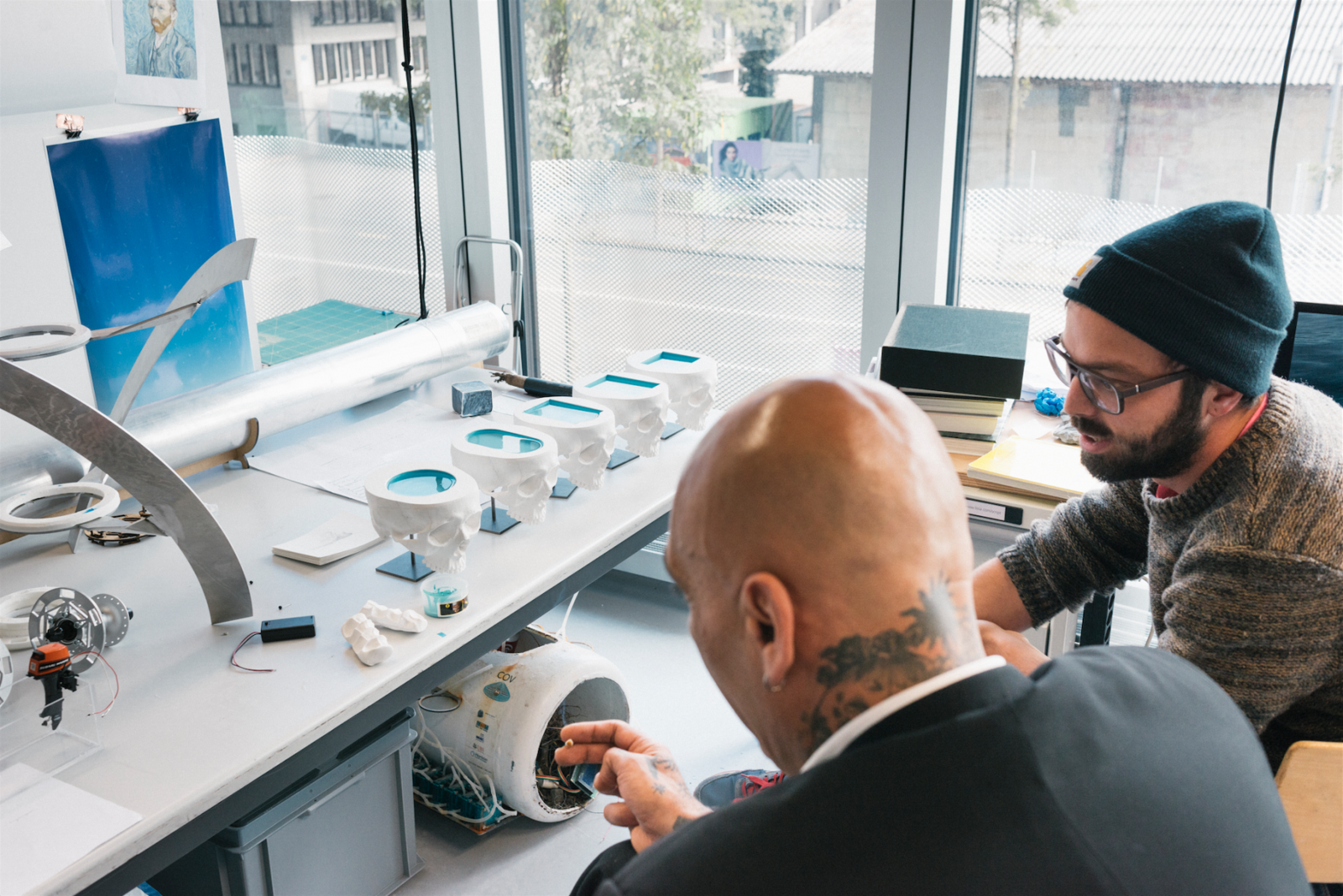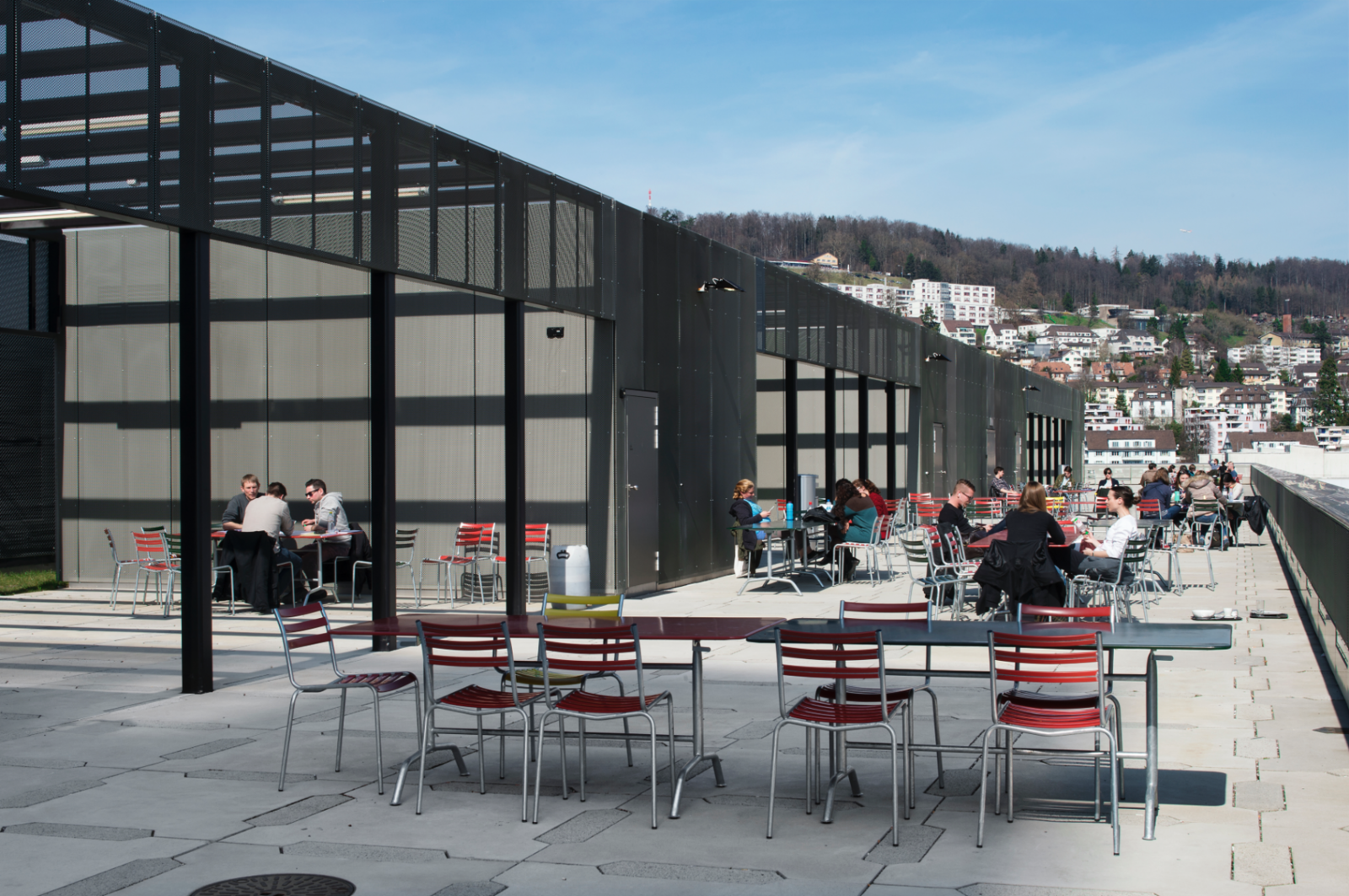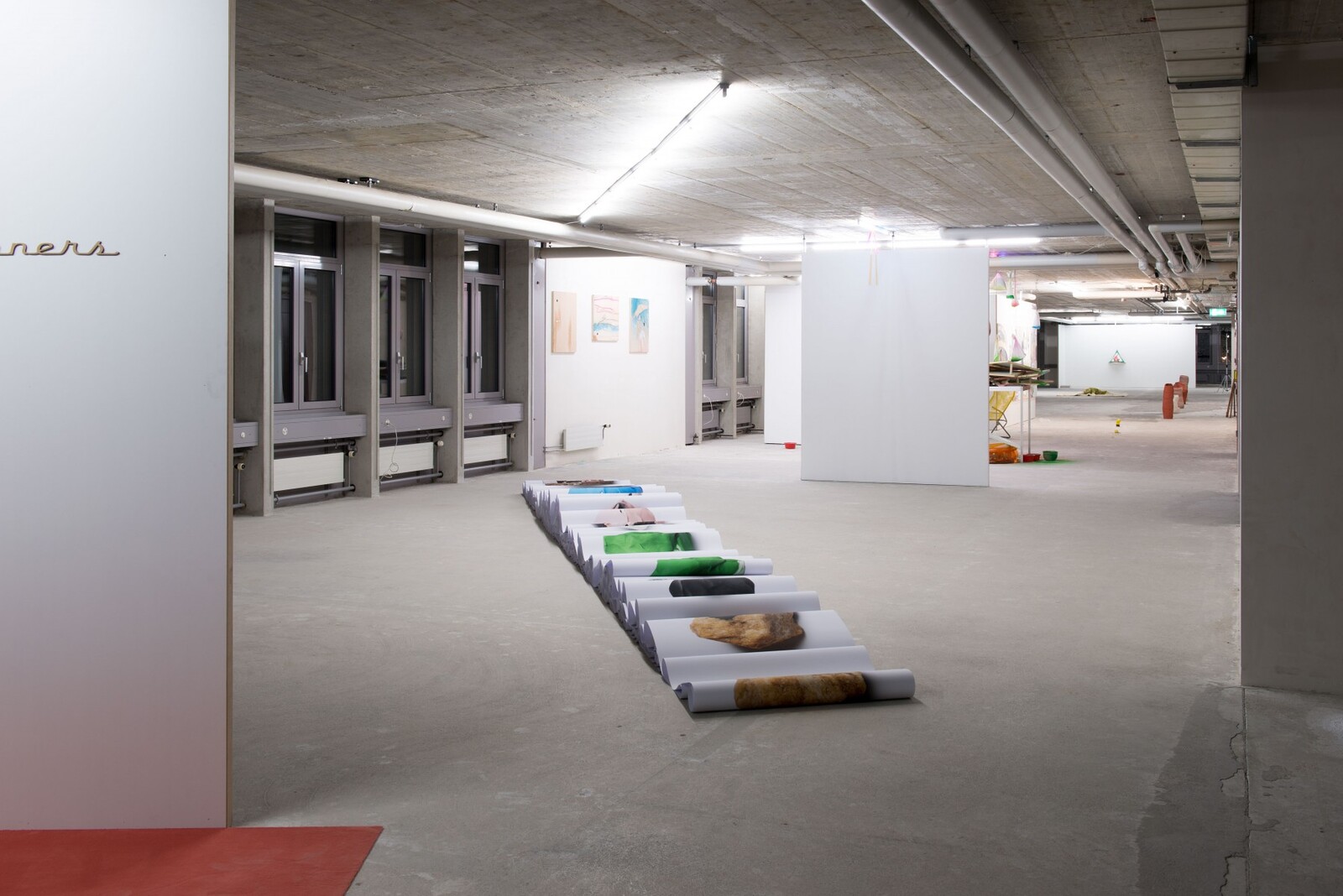The Zürcher Hochschule der Künste (ZHdK, Zurich School of the Arts) is to be found within a monolith on an arterial road heading northwest from Zurich city. This imposing structure is called the Toni-Areal, and when the ZHdK moved in last year it became what is known as the “biggest creative factory in Switzerland.” The school’s various departments date back to the nineteenth century; today it trains students in design, film, music, dance, drama, art and design education, and transdisciplinary endeavors—there’s even a master’s in Transdisciplinary Studies—as well as fine art. Within the institution, about 2,500 students come to learn; it is the largest school of the arts in the country. The building itself has always been about superlatives, whatever went on there; when first opened in 1977 it was regarded as the largest and most advanced dairy processing plant in Europe, with an impressively long vehicle ramp coiling around one end that was reminiscent of the erstwhile Fiat factory in Lingotto, Turin. (Though you didn’t need a racing track on the roof to test yogurt.) After a little more than two decades, production at the Toni plant came to a halt, leaving the city a property that didn’t easily translate into other uses (even if there was a club on the roof for several of the intervening years). Fast-forward another fifteen years and the ZHdK occupation of the Toni-Areal has become a key element of Zurich’s image, part of a vast education economy nurtured alongside the Eidgenössische Technische Hochschule (ETH, Federal Institute of Technology) and the University of Zurich.
Needless to say, artists, filmmakers, and the rest require a different kind of production line than that provided for dairy products. The Toni-Areal was subject to a major renovation and restructuring by EM2N architects before it reopened in September 2014. Now a great, broad staircase leads up to a glass entrance on one end, guiding the visitor from a land of overpasses and transit into the building’s central area—a large space for meeting, eating, and study, with the rest of the facilities located just off this main expanse. Prior to 2014 the ZHdK departments had been scattered all over the city; now they are all—bar some theater students—united. This has advantages and disadvantages, but the site certainly has prestige. The ZHdK is also not alone in the Toni-Areal—one campus of the ZHAW (Zurich University of Applied Sciences) is located there, as is one hub of the city’s Design Museum, a music club, cinema, various cafes, and even a piano shop, should you be so inclined, not to mention apartments located in newly constructed high-rises that tower over the school buildings. Though this once industrial hulk offers a surprisingly active life for artists—there are great workshops and the studio spaces are not bad at all—decent exhibition spaces are still lacking. However, these are the early days at the Toni-Areal, and art students should be able to make a minor hardship into an opportunity for innovation.
The MFA at the ZHdK was born out of another change—the Bologna reforms that aimed to harmonize third-level education within Europe. Though this applies to just about every European university and many master’s courses, the MFA in Zurich fully embraced the transformation of the previous five-year program into the reforms’ mandated two smaller units, the bachelor’s and master’s degrees. With the structural change, the nature of teaching at the MFA level was also redefined, and now is in complete contrast to the first three years of bachelor’s degree study. For the ZHdK, what prospective students undertake between the two periods is important. Artists starting the MFA directly from an undergraduate course are rare, and immediate enrollment following an undergraduate education is not particularly encouraged. Instead, maturity, independence, and responsibility are sought, with the thirty-five accepted applicants each year ranging from approximately twenty-five to fifty years old. “Good students are the alpha and omega,” MFA course leader Ulrich Görlich tells me. Not only is some experience of life and art-making outside of institutional sanctuary required, but applicants are also considered from any undergraduate discipline, as long as they can make the case for continuing their studies within a fine art context.
Competition for the MFA spots is stiff, but not impossible, with about three applicants for each of the thirty-five available placements. Though the fees are negligible in comparison to postgraduate degrees in most other European countries (just CHF 720.00 per semester), many students are still put off by the high cost of living in Switzerland. Selection is informed by an ideal breakdown of one-third local students, another third from other Swiss regions (the other side of the “Röstigraben” or “Rosti-ditch,” which divides Swiss French from Swiss German speakers and is as good as a national border in many ways), and a final third from other countries. The most recent graduating class included students from Colombia, Slovakia, Japan, and Russia, to mention just a few, and the prior and ongoing occupations or studies beyond fine art ranged from scenography and classical music to sociology and vegan cooking.
Given the ideal candidate profile, it is little surprise that many MFA students arrive with substantial exhibition experience under their belts. This becomes clear at the very start of the program, when, over two days of the first week, every single student presents to the rest of the group their work and what they aim to achieve during the course, followed by a short discussion led by one of the faculty. These sessions tend to be grueling, with little time to relax or process information between presentations. The next day the tables are turned: each teaching faculty member must present on their artistic or academic practice to the new recruits. There are few that enjoy these days and the pressurized environment is uncharacteristic of the rest of the program, but the students do start off with their minds full of new impressions.
Day to day, the course leaders’ ambition is to give theory and fine art practice equal footing, even to intertwine them. (And, further muddying this distinction, students can even decide to specialize in “theory as an aesthetic practice.”) This becomes clear from a quick survey of the teaching staff: photographer Ulrich Görlich, for example, directs the course in tandem with philosopher Jens Badura and artist Yvonne Wilhelm. Other permanent teaching staff members are Laura Arici, Brigitte Dätwyler, Christian Huebler, Dominique Lämmli, Gerald Raunig, Christoph Schenker, Giaco Schiesser (who heads the fine art department), and Erik Steinbrecher. To map the range of viewpoints in greater detail, Badura, who studied not only philosophy but also biology, history, political science, and cultural management, cites research interests including the culture of contingency and conceptualizing “verwickletes Denken”—something like “intertwined thinking,” which is a position of being open to the world and already entangled in it that builds on Leibniz’s description of knowledge. As if ease with weighty concepts wasn’t impressive enough, Badura also puts in the occasional shift as a mountain guide in his spare time. For her part, Wilhelm is one half of the art group knowbotiq (the other half is Huebler), which was formed in the 1980s, producing what was then called media art. Today they describe their work as the meeting point of art, media, and society, creating projects like the recent kotomisi—works which often have multiple iterations online, as well as installation and performance components. Gerald Raunig, meanwhile, calls himself a “skeptical philosopher” and has a critical view of the traditional, hierarchical relationship between philosophy and art, while Dominique Lämmli, who teaches drawing and painting strategies, is interested in the shifting understanding of contemporary art. The gears of the MFA are operated furiously by a small team of assistants, each of them practicing artists for whom the role offers a stepping-stone to a teaching post. And, of course, there are guest lecturers. These people are not just parachuted in for hit-and-run presentations; several, like artist Shirana Shahbazi and gallerist Jean-Claude Freymond-Guth, are “permanent guests” who return regularly over a period of at least two years to offer ongoing critique to students.
The basic modules of the syllabus are studio practice, the “Pool” seminar (chosen from what is on offer locally or from a Swiss-wide pool), a student study group, and the MA symposium. Every student must fulfill each module every semester for four semesters—many of them extending their coursework to six semesters (but more on that anon. Of the modules, studio practice counts for more than two thirds of the necessary credits, with the other three modules worth only three of thirty credits per semester. Clocking in is not a prerequisite for studio credit (and some students spend many hours in their studios while others work elsewhere) but rather active participation in group discussions of the student’s own work and that of others, and several critiques with in-house and visiting teachers. This is evaluated by means of a written “Semesterbericht” (semester report) in which the student has to reflectively measure their own work against the aims they set starting out, describing successes and failures in their research. The students do not pass or fail, though some may be asked to make their submissions more thorough, but the exercise provides a benchmark for their ongoing development. Of the remaining modules, students can choose their “Pool” seminar from either those offered by the ZHdK or by other Swiss art schools in Geneva, Lausanne, Basel, Bern, Lucerne, or Valais. These might be weekly seminars exploring a given topic, participating in symposia, attending workshops, or a combination thereof. For example, some students this semester could attend a symposium on “Innocence” at the Institut Kunst in Basel or the workshop “CAPITALISME ALIEN” at HEAD in Geneva. Erik Steinbrecher’s “three days of high energy hosted by Büro Berlin and powered by presence” also may be tempting. The student study group, on the other hand, requires students to organize themselves into groups of two to six participants and decide how to investigate a subject of their choosing; recent examples have stretched the boundaries of relevant topics to consider water supply in the city of Zurich and the parallels between the systems of art and world football.
While all the other modules can be self-organized—the students deciding whether to concentrate their learning in blocks or spread out across the semester—the MA symposia follow a set timeline. For the autumn semester the ZHdK keeps things in-house; the spring semester symposium is, again, partly shared among Swiss fine art master’s degree programs. Last year the Zurich autumn seminar “Soft Infinities,” led by curator Joerg Franzbecker and Christian Huebler of the aforementioned knowbotiq, investigated contemporary uses of the tradition of assemblage. Performances, screenings, and lectures included artists such as Emily Wardill, Riikka Tauriainen, and Helen Marten, among others. For this term, when the seminar takes place mid-November, artist Colin Guillemet will be in charge. In a bid to really test the nonhierarchical theory and practice principle, he is adopting an old-school approach: the young artists will be put through a two-and-a-half-day boot camp of the kind of hands-on making, and thinking about making, that contemporary art students rarely experience. This will be rounded off by a keynote lecture by Jeremy Gilbert-Rolfe, cofounder of October, and a discussion including Richard Wentworth, Chus Martínez, and Sally O’Reilly.
Coming to the Zurich MFA from an outsider perspective, it is initially a bit of an enigma. Why no flashy exchange programs, for instance, I wondered? Institutional links are only discreetly mentioned. But look closer and it becomes apparent that this is no production line for a particular kind of artist, but a program that works for already self-reliant and autonomous participants. In the course brochure Giaco Schiesser stresses the importance of an “eigensinnig” quality, what he calls “willful obstinacy.” The artist who knows what he or she wants from this course can march through it in two years, but they can equally spread it out for a third and combine it with research and other undertakings that complement their studies. Not only is this strength of character a useful attribute for any would-be professional artist; there is also the opportunity for MFA students to direct their own studies as they go along, and not just in the student study seminars. Ongoing discussion and feedback are cornerstones of the curriculum; students continually remodel the course with the information they send back up the chain of instruction—indeed, they have to provide these responses within each Semesterbericht.
So, after two, or three, years, how does the MFA conclude? Not how you might imagine. It turns out the jewel in the crown of the MFA is not, for example, access to the delightful roof garden at the Toni-Areal, but a degree show exhibition that takes place after students graduate. Prior to this, MFA candidates must present their work to two external and two internal examiners along with a written document in order to be granted a degree. This year, in response to student input, the degree show took place in September, following the final exams in June. This meant that all the artists exhibiting had a great deal more freedom than they would have if their final show had to encapsulate the result of two years’ study. Not only are they awarded this extra time after graduating to create the work they’d like to show; the final exhibitions and catalogues are also provided by the school.
This year the adjusted system brought forth a fresh approach—ZHdK’s Erik Steinbrecher invited critic Jennifer Allen to meet all the students for one last (epic) crit before the show to produce “Zürich Kritik,” described with tongue firmly in cheek as “a new critical method which pairs speed with excess in a way that digital natives and digital immigrants can appreciate.” Berlin-based Allen spent late spring into early summer on a tumultuous tour of artist-forming establishments in the roles of tutor, curator, and examiner: De Ateliers in Amsterdam was followed by the Art and Craft Department at Oslo National Academy of the Arts MFA Exhibition, then the MFA exhibition at Funen Art Academy, and finally Zurich. That happy accident of scheduling prior to the ZHdK visit informed her approach. She met with all the Zurich students, then they went on their way to produce their degree show works and she on hers to write a text for each and every student. The results are presented in the Zürich Kritik catalogue produced in collaboration with Steinbrecher and Winfried Heiniger of Kodoji Press. These dynamic and delightful texts that flick-flack between English and German to find the mot juste make the publication really about the artists and not just an advertisement for the school. The catalogue was given to visitors to the show, who could also enjoy a busy program of events. One evening, for example, graduates Sandra Lang and Nicolasa Navarrete held a discussion with Nicolas Martino and Ilaria Bussoni about the artist and the intellectual that spiraled into other ideas such as the refusal of work as an artistic strategy; this was followed by Andrea Palamarcûkova’s moving performance Heimatlosigkeit Denken und Sprechen (Thinking and Speaking Homelessness) about a young artist developing and realizing that she did not have the vocabulary to express artistic ideas in her mother tongue; and finally there were films by Maria Pomiansky and Ergör Gökçe.
The ZHdK MFA course is still young; 2015’s degree show was the sixth exhibition of its kind. If you want proof of the caliber of students that ZHdK has already fostered, you could look to the 2013 exhibition “It is all in the detail,” which was held at the Kunsthaus Baselland. This was a survey of artists affiliated with the MFA program: twenty-two artists were selected, among them several who are already making their mark internationally such as the duo Michael Meyer and Christoph Franz, Delphine Chapuis Schmitz, Lena Maria Thüring, and Tobias Spichtig. Other recent graduates have included Karin Hueber, Cédric Eisenring, and Thomas Julier. The latter is codirector of the alternative exhibition venue Taylor Macklin, and ZHdK is among the space’s sponsors. Employing an editorial strategy similar in its generosity to Allen’s contribution this year, the catalogue for the Baselland show included two texts by two different critics for every artist (I was one of the six writers involved). These catalogues speak to an underlying strategy on the part of ZHdK: if the MFA is characterized by a hands-off approach to the students, leaving them creative autonomy and requiring self-motivation, the school invests its resources where it can actually make a difference to fledgling careers—treating its MFAs not so much as students but as professionals.
—Aoife Rosenmeyer





